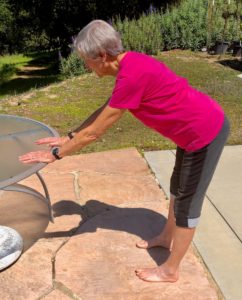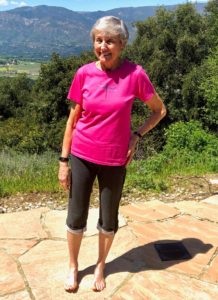Pelvic Floor Restore – 4/16/2020
““In the middle of every difficulty lies opportunity.” Albert Einstein. What opportunity could pelvic organ prolapse repair surgery present? The opportunity to start with organs that have been restored closer to their natural alignment and rebuild the supporting muscles. This post is about my rediscovery of how the pelvic floor and supporting muscles work optimally as explained and taught by biomechanist, Katy Bowman.
Pelvic Floor Restoration Post-Surgery
Three weeks after having the operation, my surgeon told me to begin doing Kegels. That sounded a lot like she thought I could strengthen my pelvic floor even after surgery. And that triggered the memory of when Katy did a blog post interview in 2010 called Pelvic Floor Party: Kegels Not Invited. The result was a flood of questions, discussions, articles and challenges regarding Kegels and the health of the pelvic floor. I had been a big Kegel fan for many years and yet I had prolapse. Katy’s biomechanical approach gave me a better understanding of how the pelvic floor muscles work and a new path for change.
Learning About Whole-Body Mobility
I found Katy Bowman in 2009 at age 71. I had been diagnosed with POP (pelvic organ prolapse) and was scheduled for repair surgery using mesh. As luck would have it, I caught a cold just before surgery was scheduled and it had to be cancelled. I like to think of it as divine intervention because I found Katy. And I found a way to change how I was moving that resulted in significant and never-expected physical changes. It wasn’t just me who experienced significant changes using Katy’s practices. My co-authors – Joyce, Lora and Shelah – all in our 70s at the time, were all seeing unexpected changes at “our ages.” You can follow our journeys and learn more in our book co-authored with Katy, Dynamic Aging: Simple Exercises for Whole-Body Mobility.
Habits and Patterns

I learned from Katy that all physical changes are not a natural result of chronological aging. In other words, let’s not blame everything that goes awry on our age. Much of what we experience as we age physically is the result of long-time habits and patterns in how we move. Getting in alignment and moving our bodies in ways that optimize the use of muscles and joints, results in changes. For me, my habits and patterns that led to POP had been going on for a very long time. Despite diligent application of Katy’s moves for ten years, the prolapse progressed to the point where surgery was necessary. In February this year, I had the POP repair.
Restoring the Pelvic Floor
Now, the prolapse has been surgically repaired. My organs have been restored closer to their natural positions. The opportunity for me is to continue with my new habits and patterns and begin again to restore the muscles of my pelvic floor using Katy’s practices. A new journey begins to optimize my pelvic floor health so I can minimize the chances of recurring prolapse.
Pelvic Floor Exercises
In her book, Move Your DNA, Katy devotes an entire chapter to the pelvic floor, It is called Not Your Great-Great-Great-Great-Great-Great-Great-Great-Great-Great Grandparents’ Pelvis. She emphasizes that pelvic floor health depends on how we move our whole-body. And she offers some specific moves that are particularly relevant.

Katy explains that the pelvic list builds lateral hip strength. This is key to walking so that “pelvic floor function and sacral and pelvic stabilization are the natural byproducts.” She analogizes optimum walking to rowing a boat. Using one leg at a time, extending one hip at a time, pushing back and “rowing” our body forward. All our body weight has to be held by the lateral hip muscles of the leg that is pushing back on the ground. “Your hip muscles do this—hold the weight of your body in the lateral hip, extend the thigh bone, stabilize the pelvis and sacrum and support the function of the pelvic floor—all at the same time.”
While rowing your body forward when you walk, you are engaging more gluteal (backside/butt) muscles. This results in an increase in muscle mass and strength. Over the past six weeks of walking (rowing) my body forward, I am noticing a build-up of gluteal (butt) muscle. Who knew this was possible “at my age?!?”
The Monster Walk
Click on this heading and it will take you to Katy teaching this exercise. It is one of my faves and great for the glutes and pelvic floor.
Bottom Line (Couldn’t Resist!)
In the end (I think I am on a roll here) what have I got to lose by practicing (as I am cleared to do so) all of Katy’s great exercises. This will work on restoring both my pelvic floor and my whole-body strength and mobility. If I decide I want to include Kegels, I will follow Katy’s suggestion to do them while I am squatting! Click here for her great progression of exercises for learning to do the squat.
* * * * *
My Gifting Vision

In my January post, 2020 Vision, I shared my vision as a certified personal life coach to connect with at least 100 different people in 2020. I want to gift the experience of coaching by giving an introductory call. This is your opportunity for a win-win – support me in connecting and add something to your 2020 Vision. How risky does that feel to you – the thought of emailing me and scheduling a coaching call just to see what it is like? Would that be a s-t-r-e-t-c-h for you? What is getting in the way of you taking that risk, sending that email? Could this be a first step in stepping out of your comfort zone and into a world of possibilities? You’ll never know unless you do it! And, I can help you discover and create your 2020 Vision through coaching.
Why have a Vision
Why have a vision? To get 20/20 vision about your life?. Having a vision can give you the clarity and passion to move in a fulfilling direction. Visions can change. When you feel stuck or lack passion, chances are it is because you do not have a clear vision of what you want. Here’s an opportunity to make a change in your life.
Coaching 4 Dynamic Aging
Now is the Time
Joan Virginia Allen, Certified Dynamic Aging Coach

Congratulations on your “new” pelvis as well as the new focus in your life! Likely we’ll all benefit.
I must explain or defend Dr. Kegel, who ended his career teaching at Loma Linda Medical School. He taught a method for strengthening only the vaginal muscles: he’d take a stainless steel “sound,” which came in graduated sizes, and was made of stainless steel (very cold) and briefly insert it into the vagina. One needs that once only as the muscle action can be done anytime when one knows where they are.
At that time surgeons were “tightening” the muscles surgically, so many surgeons were not happy about his very successful, cheap and pain-free method.